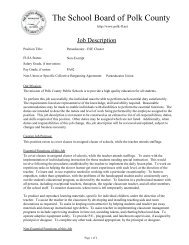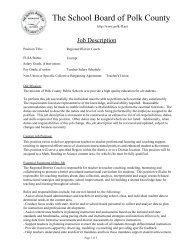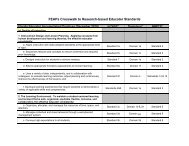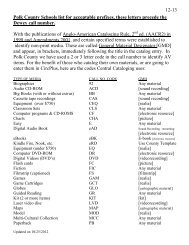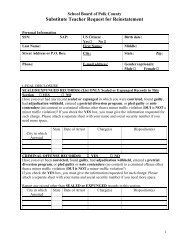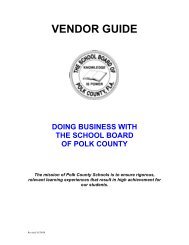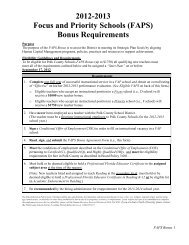Thirty Days to Unlock FCAT Writing Success - Polk County School ...
Thirty Days to Unlock FCAT Writing Success - Polk County School ...
Thirty Days to Unlock FCAT Writing Success - Polk County School ...
You also want an ePaper? Increase the reach of your titles
YUMPU automatically turns print PDFs into web optimized ePapers that Google loves.
Elaboration Using Sensory Language<br />
Hershey Kiss Discovery<br />
• Students create a writing piece using their senses of sight, <strong>to</strong>uch, smell and taste <strong>to</strong> describe<br />
the outside and inside of a Hershey Kiss without using the words chocolate, Hershey, or Kiss.<br />
The Naming of the Shoe<br />
• Foster different modes of writing focusing on elaboration strategies.<br />
Build curiosity the day before the assignment by telling students <strong>to</strong> be sure <strong>to</strong> wear socks<br />
with no holes the next class day. The day of the assignment, have students take out paper<br />
and pen. Assign them an identifying number- students are NOT <strong>to</strong> put their names on their<br />
papers. Next, have them take off both shoes and place the right one inside a large plastic<br />
bag which you will keep at your desk. Instruct students <strong>to</strong> place the left one on <strong>to</strong>p of their<br />
desks. Allow students 10-15 minutes <strong>to</strong> describe in detail their left shoe. After they have<br />
described their shoe, they may give it a personality, name, tell where the shoe has been,<br />
how they value their shoe, or why they chose that type of shoe (encourage creativity).<br />
After allowed time, collect all papers. Students place their left shoe in a pile centrally<br />
located in the room. Be sure shoes are "mixed up" and the right shoes remain hidden. A<br />
volunteer selects a paper and reads it aloud <strong>to</strong> the class. Volunteers may NOT read their<br />
own paragraphs. The teacher moni<strong>to</strong>rs this by the assigned identifying numbers. If the<br />
volunteer/reader can find the correct shoe from the DESCRIPTION, the owner of the shoe<br />
gets <strong>to</strong> put on both shoes. Should the reader not choose the correct shoe, the paper goes<br />
back in the stack and no shoe is taken from the pile. The student whose paragraph was<br />
written well enough <strong>to</strong> regain his/her shoe, selects and reads the next paper. This continues<br />
until all shoes are gone from the pile. This activity could also be conducted in small groups,<br />
so that students would get their shoes back faster!<br />
Sense(ability) Sense(itivity)<br />
• Use the SENSORY WORD CHART <strong>to</strong> create paragraphs and essays that include sight,<br />
sound, <strong>to</strong>uch, taste, and smell. Hand out the SENSORY WORD CHART <strong>to</strong> each student. Ask<br />
students <strong>to</strong> use one word from each column <strong>to</strong> write a short paragraph. After five minutes,<br />
ask for student volunteers <strong>to</strong> read their work. Explain how the addition of this sensory<br />
elaboration increases the substance of the piece.<br />
Continue the activity by asking students <strong>to</strong> select one more sensory word from each column<br />
<strong>to</strong> add <strong>to</strong> the first paragraph. Start a second paragraph that extends the ideas presented in<br />
the first paragraph. Use more sensory words in this paragraph. Use as many of the words<br />
from each column as needed <strong>to</strong> reinforce adding sensory elaboration <strong>to</strong> the writing.<br />
• Extension:<br />
Assign a row from the list of SIGHT words from the chart <strong>to</strong> create a SIGHT poem using all of<br />
the words.<br />
Assign each of the other rows one of the sensory <strong>to</strong>pics: SOUND, TOUCH, TASTE & SMELL.<br />
Tell each row they need <strong>to</strong> create a poem specific <strong>to</strong> that sensory <strong>to</strong>pic.<br />
Ask for volunteers <strong>to</strong> read the sensory poems.<br />
Illustrate the poems with related sensory images or symbols.<br />
Keep the SENSORY WORD CHART in a writing portfolio for future use.<br />
55



